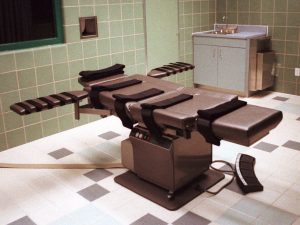News
Federal Government Executes 1st Prisoner In 17 Years After Overnight Court Rulings
By: Carrie Johnson | NPR
Posted on:
Updated at 8:53 a.m. ET
The Justice Department has put to death Daniel Lee, 47, marking the first federal execution since 2003, after a chaotic overnight series of court rulings.
Lee had been convicted of killing three people, including a child, as part of a broader racketeering scheme to fund a white supremacist cause. He had waited more than 20 years on federal death row in Terre Haute, Indiana.

Lee, strapped to a gurney and connected to an IV in his left arm, said: “I didn’t do it. I’ve made a lot of mistakes in my life but I’m not a murderer,” according to a pool report from the prison.
Lee blamed a judge in Arkansas for ignoring DNA evidence in his case and said he was on the other side of the country when the killings happened. He said at one point, “I bear no responsibility” for the murders in his case, according to the pool report.
Lee’s last words were, “You’re killing an innocent man.”
As a senior Bureau of Prisons official told Lee that he was being put to death, the condemned man shook his head, according to the pool report.
A U.S. Marshal lifted a black telephone inside the execution room — a small square room with green tiles and windows looking at the witness’ rooms, where observers were able to see what was taking place — and asked if there was anything to impede the execution. He said there was not and the execution could proceed.
The time of death was 8:07 a.m.
A statement by the Bureau of Prisons following the execution described the gruesome 1996 murders of William Frederick Mueller and Nancy Ann Mueller and their daughter, Sarah Elizabeth Powell, age 8, along with Lee’s 1999 conviction by a jury in the case.
Way cleared after court ruling
The execution followed an early morning 5-4 decision by the U.S. Supreme Court, which rejected a challenge to the single drug protocol authorities used in the lethal injection.
Chief Justice John Roberts concluded Lee and other men on death row had virtually no chance of succeeding in their claim that pentobarbital injections amounted to cruel and unusual punishment under the Eighth Amendment.
Roberts said five states use pentobarbital in their execution protocols and that about 100 death sentences already had been carried out with that method.
The high court’s four liberal justices dissented. Stephen Breyer raised doubts about the constitutionality of capital punishment, pointing out that Lee’s co-defendant, considered more culpable in the murders, had received a life sentence.
Justice Sonia Sotomayor decried the rush to execute Lee, rather than build a fuller record in the lower courts. The federal appeals court in Washington, D.C., had earlier agreed to expedite proceedings there over the lethal injection process.
“In its hurry to resolve the government’s emergency motions, I fear the court has overlooked not only its prior ruling, but also its role in safeguarding robust
federal judicial review,” Sotomayor wrote.
The Supreme Court also refused to consider a claim by Earlene Peterson, 81, a relative of Lee’s victims, who had asked the Bureau of Prisons to delay the execution until the coronavirus pandemic had ended, so she could attend the proceedings.
9(MDI4ODU1ODA1MDE0ODA3MTMyMDY2MTJiNQ000))

